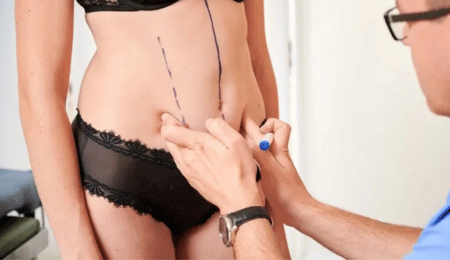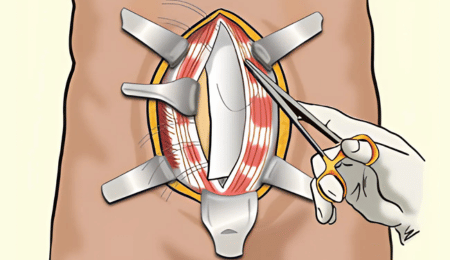Advances in Abdominal Wall Reconstruction
Abdominal Wall Reconstruction: Latest Techniques

Introduction
Abdominal wall reconstruction (AWR) has seen remarkable progress over the past few years, becoming a critical procedure for patients dealing with complex hernias, trauma, or previous unsuccessful surgeries. With improved techniques, materials, and surgical strategies, AWR offers renewed hope for patients seeking both functionality and aesthetics. In this blog, we will explore the fundamentals of abdominal wall reconstruction, discuss why hernias require surgical intervention, outline post-surgical expectations, and introduce expert insights from leading surgeon Dr. Vinay Jacob.
Understanding Abdominal Wall Reconstruction
Abdominal wall reconstruction is a complex surgical procedure designed to restore the integrity and strength of the abdominal wall. It is often performed to treat large or recurrent hernias, especially when traditional hernia repairs have failed. The abdominal wall is a vital structure composed of layers of muscle and connective tissue, responsible for protecting internal organs and supporting movement.
Reconstruction involves repairing or replacing damaged tissues, using techniques such as component separation, mesh reinforcement, or flap surgery. These methods aim to restore both function and appearance, especially in cases where there has been significant tissue loss or scarring.
Why is Surgery Used to Treat Hernias?
Hernias occur when internal organs or tissues protrude through a weak spot in the abdominal wall. While some small hernias may be monitored, most require surgical repair to prevent complications such as bowel obstruction, strangulation, or chronic pain.
Surgery is the only definitive way to repair a hernia. It allows the surgeon to push the protruding tissue back into place and strengthen the weakened area using sutures, mesh, or tissue flaps. Left untreated, hernias can grow larger and lead to severe health risks. Abdominal wall reconstruction is particularly vital in complex cases involving large or multiple hernias.
Causes and Common Concerns
Abdominal wall defects can arise due to multiple factors:
- Previous abdominal surgeries
- Trauma or injury
- Infection or wound breakdown
- Obesity or rapid weight gain
- Congenital defects
Patients often experience symptoms such as visible bulging, discomfort, and restricted mobility. Additionally, aesthetic concerns and psychological distress can significantly affect quality of life. Timely diagnosis and a personalized treatment plan are essential to achieving the best outcomes.
Treatment Options and Surgical Techniques

Advancements in AWR have led to the development of several surgical techniques:
Component SeparationThis method involves separating and advancing abdominal muscles to close large defects without tension.
Mesh ReinforcementSynthetic or biologic mesh materials are used to strengthen the abdominal wall and reduce recurrence risk.
Flap SurgeryTissue flaps from nearby areas are used when local tissue is insufficient, ensuring durable coverage.
Minimally Invasive ApproachesLaparoscopic and robotic-assisted techniques offer smaller incisions, quicker recovery, and reduced complications.
What is Abdominal Wall Reconstruction Surgery?
AWR surgery involves meticulous planning and execution to restore abdominal strength and function. It may last several hours, particularly for complex cases. Surgeons evaluate the patient’s medical history, perform imaging studies, and decide on the best reconstruction strategy. The goal is to eliminate hernia recurrence, relieve pain, and improve abdominal contour.
What Happens After Abdominal Wall Reconstruction Surgery?
Recovery from AWR involves a carefully monitored hospital stay, typically ranging from a few days to a week. Patients are advised to avoid heavy lifting and strenuous activities for several weeks. Pain management, wound care, and physiotherapy may be necessary to ensure complete healing.
Follow-up visits are essential to track recovery progress and detect any early signs of complications. Most patients experience a significant improvement in physical function, comfort, and self-confidence post-surgery.
Meet Dr. Vinay Jacob – A Leading Expert in Abdominal Wall Reconstruction
Dr. Vinay Jacob is a highly qualified and accomplished Senior Plastic and Reconstructive Surgeon in India with over 25 years of experience. He earned his MBBS from St. John’s Medical College, Bangalore, in 1991, followed by an MS from Tata Memorial Hospital, Mumbai, in 1996. In 2001, he received the Magister Chirurgiae (MCh) and Diplomate of the National Board (DNB) in Plastic Surgery with Distinction.
Dr. Jacob is renowned for his expertise in various complex procedures, including abdominal wall and hernia repair, gender-affirming surgeries, hand and facial rejuvenation, body contouring, and neurological pain relief surgeries. Patients can consult Dr. Jacob at the Reconstructive Surgery Centre, 503, Sagar Fortune Building, Above A Kreations, Waterfield Road, Bandra (West), Mumbai - 400050.
FAQs on Abdominal Wall Reconstruction
1. Is abdominal wall reconstruction surgery safe?Yes, when performed by a skilled surgeon, the procedure is safe and offers excellent long-term outcomes.
2. How long does the recovery process take?Most patients resume light activities within 4-6 weeks, but complete healing may take up to 3 months.
3. Will I have a visible scar after surgery?Some scarring is expected, but surgeons strive to minimize visibility and promote optimal healing.
4. Can abdominal wall reconstruction fix all types of hernias?It is primarily used for complex, large, or recurrent hernias. Your surgeon will recommend the best approach based on your case.
5. Is mesh always used in AWR surgery?Not always. The use of mesh depends on the size of the defect and tissue condition.
6. Will my hernia come back after AWR?Recurrence rates are low with modern techniques, especially when patients follow post-op guidelines.
7. Does insurance cover abdominal wall reconstruction?Coverage varies. It is often covered when deemed medically necessary. Confirm with your insurance provider.
8. When should I consult a doctor for hernia or abdominal wall issues?If you experience pain, bulging, or discomfort in your abdomen, consult a specialist for evaluation.
Conclusion
Abdominal wall reconstruction is a life-changing procedure that restores both form and function, especially for patients with complex hernias or abdominal wall defects. With modern advancements and expert surgical care, outcomes are better than ever. If you or a loved one is considering abdominal wall reconstruction, consult an experienced surgeon like Dr. Vinay Jacob to explore the best options for your needs. Remember, timely action and professional care can lead to lasting recovery and improved quality of life.

